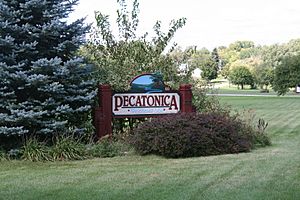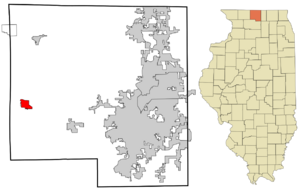Pecatonica, Illinois facts for kids
Quick facts for kids
Pecatonica
Bekka or Pekka
|
|
|---|---|

Sign leading into the south side of Pecatonica
|
|
| Motto(s):
Small Town, Bright Future
|
|
 |
|
| Country | United States |
| State | Illinois |
| County | Winnebago |
| Township | Pecatonica |
| Area | |
| • Total | 1.31 sq mi (3.39 km2) |
| • Land | 1.28 sq mi (3.32 km2) |
| • Water | 0.03 sq mi (0.07 km2) |
| Elevation | 771 ft (235 m) |
| Population
(2020)
|
|
| • Total | 2,090 |
| • Density | 1,628.99/sq mi (628.77/km2) |
| Time zone | UTC-6 (CST) |
| • Summer (DST) | UTC-5 (CDT) |
| ZIP code(s) |
61063
|
| Area code(s) | 815 |
| FIPS code | 17-58408 |
| Wikimedia Commons | Pecatonica, Illinois |
| Website | http://www.villageofpecatonica.com/ |
Pecatonica is a village located in Winnebago County, Illinois, in the United States. It is part of the larger Rockford area. In 2020, about 2,090 people lived there.
Contents
Village History
Pecatonica gets its name from the Pecatonica River. This river forms the northern edge of the village. The name Pecatonica comes from two Algonquian language words. Bekaa (or Pekaa) means slow, and niba means water. So, Bekaaniba means Slow Water.
Early Days and Railroads
Before Pecatonica became a village, the area was sometimes called "Lysander." In 1853, the Galena and Chicago Union Railroad (which later became the Chicago & North Western Railroad) built tracks through the area. This railroad connected Pecatonica to Chicago and Freeport, Illinois. The arrival of the railroad made Pecatonica an important trading center for western Winnebago County.
The Village of Pecatonica was officially created in 1869. A man named C.W. Knowlton opened his first bank here in 1882. He also built a beautiful Queen Anne Victorian house on Main Street. This house is still standing today.
Electric Train Line
An electric train line, called the Rockford & Interurban, started running in 1902. It connected Rockford to Pecatonica, going through Winnebago, Illinois. This line continued on to Ridott, Illinois and Freeport. The electric train stopped running in 1930. A small building that was once a train station still stands near Main Street.
Pecatonica Prairie Trail
The old electric train route between Pecatonica and Winnebago often runs next to the Pecatonica River. Today, this path is a nature trail called the Pecatonica Prairie Trail. It's a great place for walking and biking. You can find maps of the trail online.
Before trains, people traveled through this area by stagecoach. There's an old stone house on Comly Road from that time. You can even see old wagon wheel marks near the 12 Mile Grove Cemetery. This cemetery is close to U.S. Route 20, a main road in Northern Illinois.
Geography
Pecatonica is located at 42.309955 degrees North latitude and -89.358647 degrees West longitude.
The village covers about 1.3 square miles (3.39 square kilometers). Most of this area is land, with a small part being water.
Education
Students in Pecatonica attend schools run by the Pecatonica Community Unit School District #321. The district has three school buildings.
School Buildings
- The Elementary School was first built in 1938. It was used as a high school for many years. Additions were built in 1962 and 1970.
- The Middle School was also a high school building before. It was built in 1958, with additions in 1967 and 1970.
- The current High School building opened in 2003. It is a modern facility, about 107,000 square feet in size.
High School Facilities
The new high school complex includes a football field and an eight-lane track. There is also a baseball field and open spaces for physical education classes. This building was designed to be used by both the school and the community.
Parks and Recreation
Pecatonica offers several places for outdoor fun and activities.
Sumner Park
North of downtown Pecatonica, you'll find Sumner Park. This park has many features for sports and play:
- Three baseball fields
- Four tennis courts
- Two basketball courts
- Horseshoe pits
- Children's playgrounds
Pecatonica Wetlands Forest Preserve
Sumner Park connects to the Pecatonica Wetlands Forest Preserve. This preserve covers over 1,000 acres. It has flood plain forests, marshes, and upland forests along the Pecatonica River. It's a great place to see spring flowers and many different kinds of birds. The preserve is still being developed. When finished, it will have fishing spots, hiking and horse riding trails, picnic areas, and wildlife viewing spots.
Other Outdoor Areas
The Seward Bluffs Forest Preserve is also nearby. Together, these parks and the Pecatonica Prairie Trail offer many ways to enjoy the outdoors. The Pecatonica River is also a popular spot for fishing.
Winnebago County Fair Grounds
The Winnebago County Fair Grounds are very large, with over 108 acres. They host many different events throughout the year, such as:
- Music festivals
- Motor sports events
- Auto and trade shows
- Conventions
- Antique markets
- Social events
- The annual Winnebago County Fair
Population Information
| Historical population | |||
|---|---|---|---|
| Census | Pop. | %± | |
| 1880 | 1,029 | — | |
| 1890 | 1,059 | 2.9% | |
| 1900 | 1,045 | −1.3% | |
| 1910 | 1,022 | −2.2% | |
| 1920 | 1,088 | 6.5% | |
| 1930 | 1,152 | 5.9% | |
| 1940 | 1,302 | 13.0% | |
| 1950 | 1,438 | 10.4% | |
| 1960 | 1,659 | 15.4% | |
| 1970 | 1,781 | 7.4% | |
| 1980 | 1,732 | −2.8% | |
| 1990 | 1,760 | 1.6% | |
| 2000 | 1,997 | 13.5% | |
| 2010 | 2,195 | 9.9% | |
| 2020 | 2,090 | −4.8% | |
| U.S. Decennial Census | |||
In 2000, Pecatonica had 1,997 people living there. There were 791 households, with many families. About 38.8% of households had children under 18. The average age of people in the village was 37 years old.
Famous Residents
- Trisha Paytas
See also
 In Spanish: Pecatonica (Illinois) para niños
In Spanish: Pecatonica (Illinois) para niños

